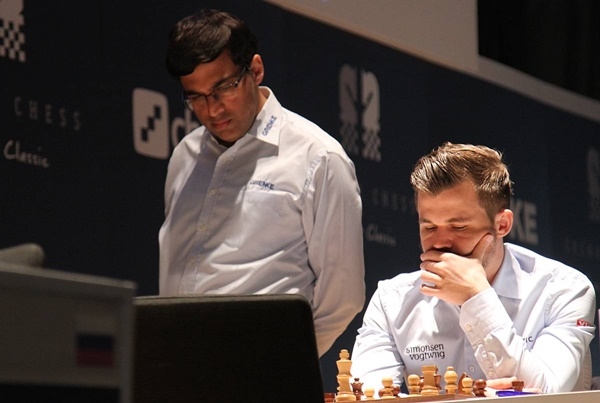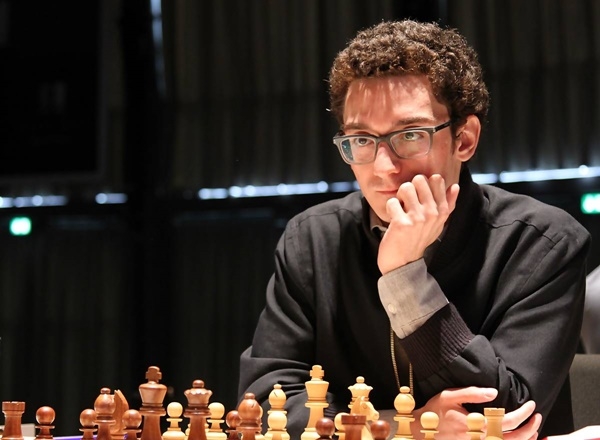


After saving a half point against Magnus Carlsen on Monday, Vishy Anand had the black pieces for a second round in a row, this time against Francisco Vallejo Pons. The former world champion responded to 1.e4 with the Caro-Kann Defence and put all his hopes on a queenside expansion. When most pieces had been developed and the landscape of the battleground had been established, Anand felt he was simply worse, but Vallejo could not find the best way forward:
Vishy confessed that he mostly feared 19.g5 ♞fd7 20.♕h5, when White's attack would be difficult to parry. Instead, Paco played 19.♘f3, allowing Black to continue his queenside development with 19...c4.
White kept pushing for a direct attack against the king, but soon enough Black managed to close the position on that side of the board. At the same time, Anand invaded on the queenside with his queen and correctly calculated that he could give up his strongest piece in exchange for a big portion of White's army:
Follow the line played by Vishy on the diagram above!
Vallejo had just blundered with 36.♗e2?, counting on 36...♛xd2 37.♗xh5 ♛xg5 38.♗xg6+ ♚xg6 39.♖g2, when there is no way to save the black queen. However, Anand had seen all this and knew in advance that Black is winning after 39...♛xg2+ 40.♔xg2 ♜h8. The time control was reached and Paco played seven more moves before giving up the full point in a hopeless position.

An empty hall, after the Open finished on Monday | Photo: Georgios Souleidis
The biggest theoretical battleground during — and after — the 2018 World Championship match was the Sicilian Sveshnikov. Carlsen prepared this variation to neutralize Fabiano's king's pawn opening and managed to use this formation successfully in future games (Caruana also played the notorious line with Black a couple of days ago).
In Monday's fourth round, the players repeated the line explored in game twelve of the match (that was also the last time they had played a classical game). Instead of 13.♕a4, Caruana went for 13.♗g5, following the idea used by Sergey Karjakin against Magnus in Shamkir, but then went 14.♕a4 nonetheless:
Carlsen immediately responded with 14...♝d7, threatening ...a6 and demonstrating he has this line analysed to the core.

All eyes on the champ | Photo: Georgios Souleidis
The tense struggle continued without any of the players getting a considerable edge at any point. Nonetheless, the world champion was the one putting pressure, until Caruana decided to get into a rook and knight versus rook endgame in order to ease the defensive task:
After 46.♗xg6 ♞xg6 47.♖b6 the pawns did not take long to leave the board and the theoretically drawn endgame was played out until move 71, when only the kings and the black knight were left on the board.

Fabiano is half a point behind the leaders | Photo: Georgios Souleidis
If Vincent Keymer manages to join the elite in the future — a very likely occurrence — he will certainly remember this event as a huge learning experience. The 14-year-old German lost for a fourth day in a row, but, for a third time in Karlsruhe, he got an excellent position out of the opening.
His latest opponent, Arkadij Naiditsch, decided to expand on the kingside, and in a critical position Vincent missed a chance to close that side of the board and get a lasting advantage:
Instead of 21...♞cxe5, Keymer should have gone 21...g5, putting the brakes on White's attack, looking for a slow manoeuvring game that would favour his positional trumps. After the text, though, the game continued 22.♗xh6 ♜fe8 23.fxg6 fxg6 24.g5, and Vincent faltered in the midst of a complex struggle with 24...♞f7.
Soon afterwards, Naiditsch proved his tactical strength by giving up a knight and an exchange in order to open some lines against White's king:
Arkadij made an impression with the two-move sequence 27.♘h5 gxh5 28.♖f6 and kept playing accurately until forcing Keymer's resignation:
Needless to say, Vincent was in deep time trouble. Naiditsch played 36.♘f6+ and the youngster resigned without allowing 37.♕g8# to appear on the board.

It was a fine attack by Arkadij | Photo: Georgios Souleidis
After getting his first win of the tournament, Levon Aronian joined the commentary team and uttered a memorable aphorism: "Chess should be slow and beautiful". He was interviewed once again afterwards and, when the press officer asked him about the maxim, Levon explained:
I generally like the games when there's a lot of manoeuvring, you know, when there are a lot of plans...a strategical game. I mentioned the game as it was [played before], you know, Chaturanga, the mother of chess, [which] was a much slower game, with lots of slow development of pieces.
The Armenian took down Peter Svidler, who was sharing the lead after winning consecutively in rounds two and three. Until moves 15-16, the players reviewed a line explored by Sergey Karjakin and Svidler in 2014 and 2016. As explained by the commentators, Peter could never quite co-ordinate his play in the opening. This led to Aronian winning a pawn on move 25:
After 23.♕e3, Black has nothing better than 23...♛xe3, losing a pawn after 24.♖xe3 c5 25.♘xe5. Levon manoeuvred his pieces slowly — and beautifully — until Svidler gave up shortly before the time control was reached.

A couple of gentlemen, on and off the board | Photo: Georgios Souleidis
In another slow encounter, Maxime Vachier-Lagrave defeated Georg Meier with the black pieces. The Frenchman played a sideline of his pet Grünfeld Defence with 5...dxc4, leading to a rather quiet queenless middlegame. Despite the absence of brilliant tactical shots, numerous small calculations were needed by both players to keep the balance in the position. When the 40th move was reached, each side had a rook and a knight with connected passed pawns on opposite flanks:
MVL kept looking for chances with his advanced pawns and active king, until first gaining a pawn and then forcing Meier to go into a rook v knight endgame. By move 94, the German grandmaster decided it was useless to keep going and resigned the game.

MVL still trusts his Grünfeld Defence | Photo: Georgios Souleidis
GM Yannick Pelletier analysed the action from Round 4
So, after four rounds, Carlsen and Anand share the lead on 3 points, but they have no less than four (highly dangerous) chasers a half point behind: Caruana, Vachier-Lagrave, Aronian and Svidler. Round five will be the last one before the rest day, when Carlsen-Naiditsch and Anand-Caruana will be on the menu.